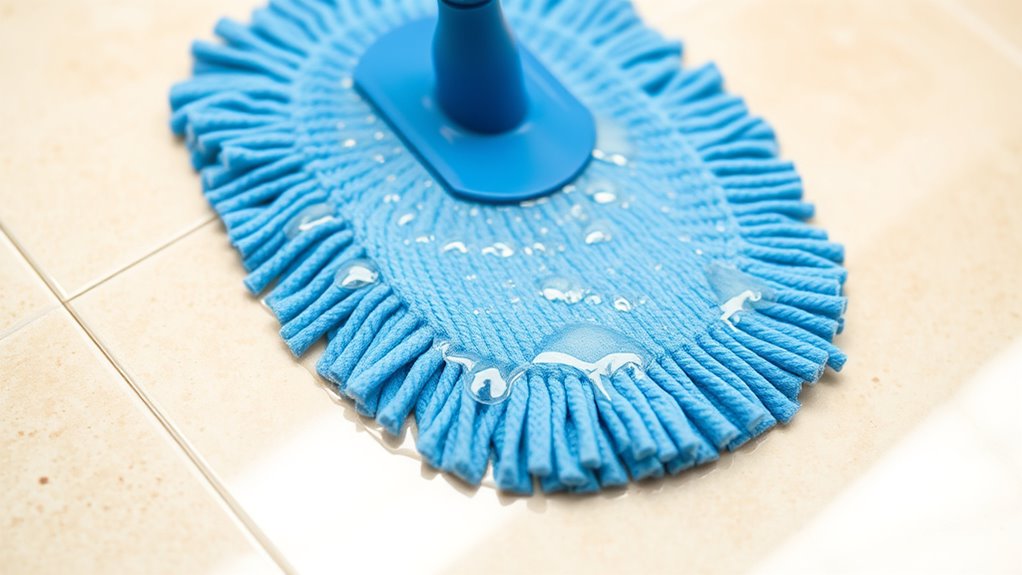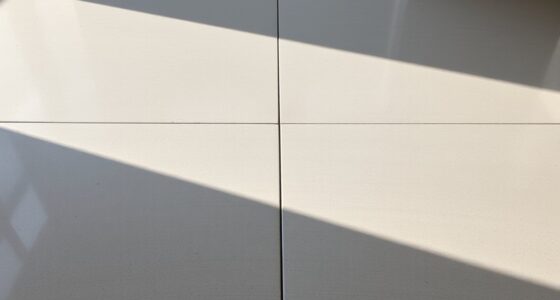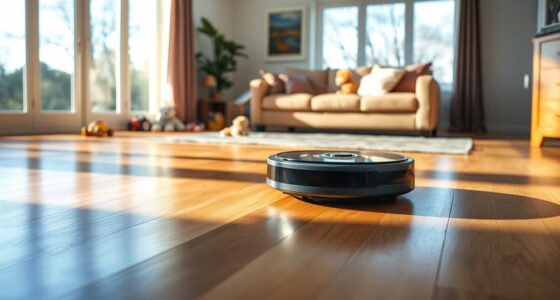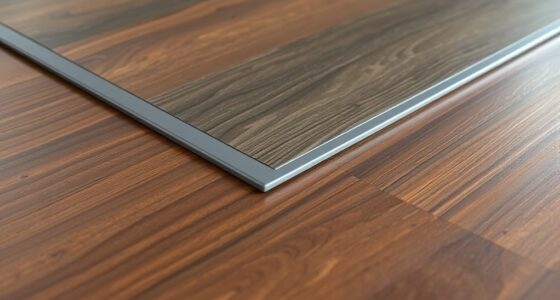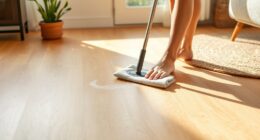When mopping tile floors, keep your damp mop slightly moist—meaning it should be damp but not dripping wet. Wring out excess water thoroughly before each pass, and avoid soaking the surface, as too much moisture can seep into grout and cause damage or slip hazards. Using a properly damp mop helps you clean effectively while preventing floor damage and maintaining safety. To discover more tips on safe and efficient mopping, keep exploring the essential practices.
Key Takeaways
- Use a mop that is damp, not soaked, to prevent excess water from seeping into grout lines.
- Wring the mop thoroughly so it remains damp but not dripping to control moisture levels.
- Work in small sections to manage water application and prevent oversaturation.
- Rinse and wring the mop frequently to maintain optimal dampness and avoid excess water buildup.
- Dry the floor immediately after mopping or ensure good ventilation to minimize slip hazards and moisture damage.
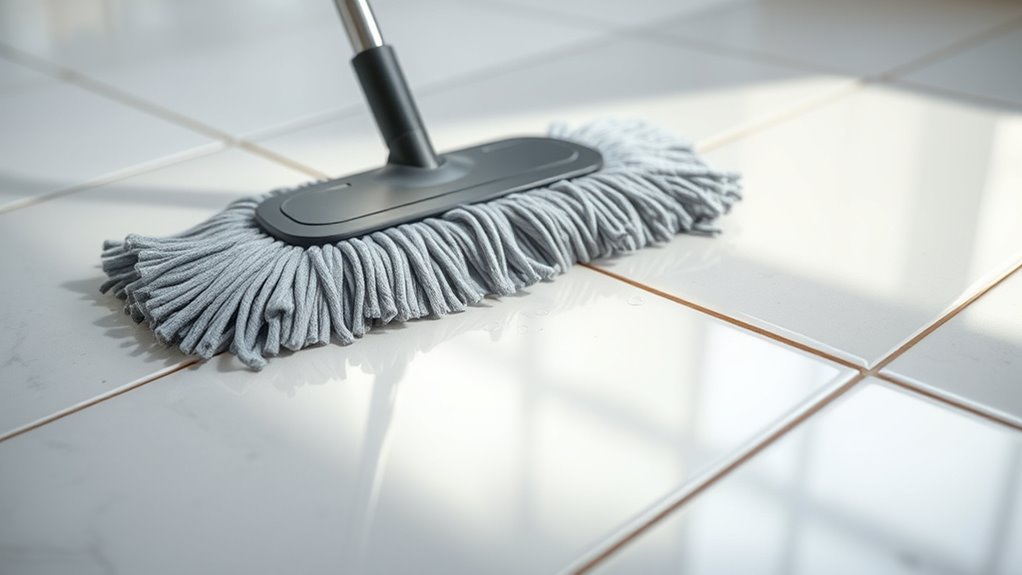
Cleaning tile floors effectively often involves using a damp mop, which helps remove dirt and grime without damaging the surface. When tackling dirt, choosing the right cleaning solutions is vital. You want solutions that are effective yet gentle enough not to harm the tiles or grout. Usually, plain water works well, but for stubborn stains, a mild detergent or specially formulated tile cleaner can make a significant difference. Always read labels carefully to verify the cleaning solutions are suitable for your tile type. Using overly harsh chemicals or too much soap can leave residue, making your floor sticky or dull over time. So, stick to recommended products and avoid excessive amounts of cleaning solution.
Use a damp mop with gentle solutions to clean tiles without damage or residue buildup.
Safety precautions are equally important when mopping your tile floors. You should always wring out your mop thoroughly, ensuring it’s damp but not soaking wet. Excess water can seep into grout lines and beneath tiles, potentially causing damage or promoting mold growth. You also want to be cautious about the amount of moisture you introduce—too much water can lead to slippery surfaces, increasing the risk of slips and falls. When mopping, work in small sections, rinsing and wringing out the mop frequently to prevent excess water buildup. Wearing slip-resistant shoes adds an extra layer of safety, especially on tiled surfaces that can become slick when wet. Incorporating automation in cleaning routines, such as smart mops, can further improve safety and efficiency.
In addition to controlling moisture levels, it’s vital to pay attention to your surroundings. Keep the area free of clutter to prevent tripping, and dry the floor immediately after mopping if possible. If you’re using any cleaning solutions, verify proper ventilation to avoid inhaling fumes, especially if you’re using chemical-based products. Read all safety labels on cleaning solutions before use and keep them out of reach of children and pets. This not only protects their health but also prevents accidental ingestion or misuse.
To summarize, maintaining safe practices while cleaning tile floors involves selecting appropriate cleaning solutions and managing moisture carefully. Your goal is to keep the tiles clean and shiny without causing damage or creating hazards. Using a damp mop properly, with the right amount of cleaning solution and safety precautions, will help you achieve a spotless, safe, and durable floor. Remember, the key is moderation—whether it’s the amount of moisture or the strength of your cleaning products—and always prioritize safety to keep your home clean and secure.
Frequently Asked Questions
Can I Damp Mop Over Sealed Grout Without Damage?
Yes, you can damp mop over sealed grout without damage. When you use a damp mop, guarantee it’s only lightly moist, avoiding excess water that could seep into the grout. Sealed grout repels water, so it helps prevent damage and staining. Regularly wring out your mop and use gentle cleaning solutions to keep your tile and grout looking fresh. This method maintains your floor’s appearance and longevity without risking harm to the sealed grout.
How Often Should I Damp Mop in High-Traffic Areas?
You should damp mop high-traffic areas at least once a week to maintain cleanliness and prevent buildup. Adjust your floor cleaning routines based on foot traffic; more frequent mopping, like every few days, may be necessary if dirt or grime accumulates quickly. Always use a well-wrung mop to avoid excess water, which can damage tile or grout over time. Consistent mopping keeps your floors looking fresh and prolongs their lifespan.
Is It Safe to Use Vinegar in Damp Mopping for Tile?
Vinegar’s versatility makes it a valuable tool for tile cleaning, but you should be cautious about vinegar safety. Using a diluted vinegar solution for damp mopping is generally safe and effective, helping remove dirt without damaging tiles. However, avoid soaking or oversaturating the surface—excess moisture can harm grout or cause slipping. Always rinse thoroughly and dry the floor afterward to maintain a safe, shiny surface.
What Are the Signs of Excessive Moisture on Tile Floors?
If you notice moisture indicators like water spots or a dull, sticky surface, your tile might have excess moisture. Watch for signs of tile warping or cracking, which suggest water has seeped underneath. Excessive moisture can also cause grout to loosen or mold to develop. To keep your floors safe, use a damp mop that’s not too wet, and promptly dry any puddles or spills.
Can Damp Mopping Cause Mold Growth on Tiles?
Sure, damp mopping can contribute to mold growth if moisture isn’t managed properly. When you leave tiles damp or neglect moisture control, mold may multiply, making cleaning more complicated. To prevent this, regularly dry tiles thoroughly after mopping, promote proper ventilation, and use mold prevention strategies. By maintaining moisture control, you keep your tiles dry, deter mold development, and keep your space fresh and safe.
Conclusion
So, when mopping your tile floors, remember: don’t soak them to the point where they resemble a swamp. Keep your mop damp, not drenched, and you’ll avoid warping or damaging your tiles. Think of it as giving your floors just enough love—like a gentle hug, not a tidal wave. Stick to this simple rule, and your tiles will stay happy and pristine, lasting longer than most blockbuster movies. Your floors will thank you for it!
